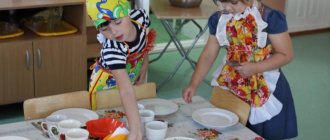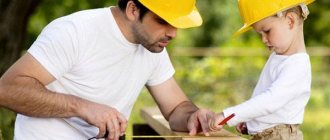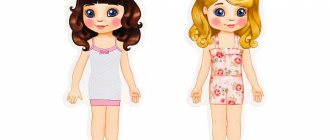Organization of manual labor in kindergarten
On the organization of
manual labor in kindergarten
“The world will be happy only when every person has the soul of an artist. In other words, when everyone finds joy in their work,” Rodin
.
Artistic work
- this is a productive and at the same time instrumental activity in which the child masters tools (scissors, knife, stapler, needle, crochet hook, etc.), explores the properties of various materials (paper, fabric, dough, foil, leaves, etc. ) and transforms them in cultural ways in order to obtain a specific result.
Artistic manual labor
combines the essential characteristics of artistic and labor activity.
Artistic manual labor
is a transformative, creative, socially motivated activity aimed at creating a specific product that harmoniously combines functional and aesthetic properties (the unity of benefit and beauty).
The main task of manual labor
– teach children to enjoy crafting, work with any available material, imagine and make cute crafts with their own hands so that the process and result of the work are visible.
Methodology for organizing work
preschool children is based on the principles
of constructing the pedagogical process
:
1. From simple to complex.
2. The principle of systematicity.
3. The principle of thematic cycles.
4. Individual approach.
5. The principle of consistency.
When conducting classes, it is necessary to take into account the specifics of the children’s age and use appropriate teaching methods and techniques depending on the assigned tasks:
- explanatory - illustrative,
- reproductive,
- problematic presentation,
- partially search engine,
- reflective techniques and methods,
- gaming.
Explanatory and illustrative: conversation, questions, reading fiction, figurative words (poems, riddles, proverbs, tongue twisters), explanation, description, reminder, encouragement, persuasion, analysis of the results of one’s own activities and the activities of comrades.
Much attention is given to clarity (teacher demonstration, example),
that is, a real object (panel made by an adult, appliqué, etc.). During classes, visualization is used in some cases to direct the child’s efforts to complete a task, and in others to prevent mistakes. At the end of the lesson, visualization is used to reinforce the result, develop figurative perception of objects, plot, and design.
Practical methods are also used in classes
(independent and joint performance of crafts). Making crafts, composing a composition in the presence of children and telling it out loud. Thus, the desire to “think out loud” is encouraged, that is, to master and pronounce actions.
To correctly develop skills in working with the simplest tools and materials, it is necessary to show and explain the teacher, certain practical actions of children under the control of an adult who monitors the correct execution of operations and the formation of skills.
Game techniques can be used in any type of activity and in each part of it: in the process of setting and motivating a task, in the performing part of the activity, in the analysis of children's activities, in the analysis and evaluation of children's work.
Methodological techniques used in manual labor
:
Examination (the teacher pays attention to technique, ornament, color, color combination, structure);
Analysis of the sample made by the teacher (discovery of the method of creation, the basis of the design);
Analysis of a series of samples made in one way (identify a generalized method of creating them);
Analysis of intermediate results and encouragement for self-control (teach comparison actions, pronounce the names of actions, designations);
Analysis of the craft (give advance instructions for self-control of the implementation of control actions, mutual control).
Classes with children can be carried out according to the following scheme:
1. The beginning of the lesson - a surprise moment, a fairy tale plot or some kind of motivation for creating the work. Riddles are asked, poems are read, conversations are held.
2. A story that is accompanied by a display of material. Children explore the shape, pay attention to color, structure, and other features.
3. Demonstration of samples, panels, applications, compositions, their analysis.
4. Explanation of creation techniques. It is important to encourage children to make suggestions about the sequence of completing the task, and to note the features of working with this material.
5. Finger gymnastics, arm warm-up.
6. Making your own crafts.
7. Analysis of finished crafts of one’s own and one’s friends.
8. Cleaning workplaces, tools, remaining material.
The content of the work.
When starting work on teaching children how to create crafts from various materials, the main attention should be paid to the children’s mastering of basic techniques. But this does not mean that creative tasks must be excluded. Often, teaching technical techniques goes hand in hand with developing children’s creativity.
Before teaching children to work with natural and waste materials, fabric and paper, it is advisable to conduct classes to become familiar with the properties of these materials. When teaching various methods of transforming materials, the most significant place among the methods and techniques used will be occupied by the process of making crafts. At the first lessons there is a full demonstration with a detailed explanation of your actions. As children gain the necessary experience, children should increasingly be involved in the show. When introducing preschoolers to various (materials) techniques, you can also use step-by-step demonstrations. In class and outside of class, the teacher develops general methods for creating crafts based on a sample, drawing, or pattern. To do this, he sets the task for children to “learn to look at a craft, read a drawing, make a pattern”
A properly organized examination of samples helps children master generalized methods of analysis - the ability to identify its main parts in an object, establish their spatial location, and highlight details.
The activity of children in transforming various materials is in itself interesting for them, and at the same time, it contributes to the formation of combinatorial skills and creativity. And the use of fiction and surprise moments in the classroom makes it even more exciting and helps to overcome emerging difficulties.
The widespread use of gaming techniques has a positive effect on children’s emotions, which in turn influence the development of creativity in preschoolers. It is necessary to strive to create an atmosphere of mutual empathy and admiration for the children’s successes in the group and in the lesson itself.
In order for the proposed tasks to become meaningful for the children, the teacher reveals the “immediate prospects” - the practical application of the acquired knowledge and skills. For this purpose, during classes, the teacher shows drawings or samples of various crafts that can be done in your free time, and after class he places visual material in the manual labor corner
Children, looking at their crafts, not only rejoice at their success in their work, but also self-critically evaluate the work.
Assessment of children's activities is carried out from the position of success in solving the assigned tasks: What went well and why, what else needs to be learned, what is the reason for failure. The content of the assessment depends on the specific task at hand. By gradually complicating the content of classes and activating children's experience, the teacher forms cognitive interest as a motive for educational activity. By applying the acquired knowledge and skills in manual labor, children realize their importance in practical activities.
Ready-made children's works have a great impact on children. They contribute to the formation of children’s interest in this work; encourage them to take initiative in improving their work skills. For this purpose, the group organizes an exhibition of children's works.
In the process of work, a child feels like an adult, and this consciousness that he is working, working like an adult, brings him joy, supports his interest and love for work.
L.V. Panteleeva, E. Kamenova emphasize the leading role of the educator, who not only explains to the child technical techniques for handling various materials, but also systematically, purposefully teaches to understand beauty, and fosters a caring attitude towards folk experience and traditions.
In order for children's work to be interesting, of high quality, and to have an aesthetic appearance, it is necessary to stimulate the creative activity of children, ensure the child maximum independence in activities, do not give direct instructions, and create conditions for the manifestation of their own imagination.
“The creation of a new image occurs through the interconnection of imagination, thinking, volition and free activity” - according to L.S. Vygotsky. “Thanks to this relationship, the imagination makes a full circle: from the accumulation and processing of impressions to the stage of gestation and design of products of the imagination.”
It is very important to teach a child to be independent - he invented it himself, he cut it himself, he sculpted it himself, he glued it himself, etc. (without simultaneously refusing to help him with the difficulties that have arisen). And it is not unimportant to educate children to be careful with their crafts, not to be distracted while working, to bring their plans to completion, not to quit work, and to help a friend finish the job.
Children's work passed through the heart has no price, it is clear that its name is exclusive and it should go down in the history of the child's development.
The collective form of conducting classes helps to create interesting, multifaceted and colorful compositions, has a positive effect on the moral and aesthetic development of the child, promotes the ability to coordinate one’s desires with the desires of other children, and help each other in difficult situations. Various forms of association are used: in pairs, in small groups, as a whole group, each separately to combine into a common composition.
The content of artistic work of preschoolers is
:
v Working with fabric and threads:
- decorative applique,
- collages made of fabric, beads, beads,
- weaving, weaving;
— production of panels, doll clothes, parts of costumes for games, souvenirs;
v Working with natural materials:
– production of small and large sculptures – animal painting,
- making decorative collages from dry plants, straws,
- weaving from twigs, dry grass,
- making decorative bouquets,
- design of a living corner;
v Working with paper, cardboard
:
- applique made from paper of different textures in combination with fabrics and natural materials,
— production of decorative panels, postcards;
— production of three-dimensional and flat objects and structures for holiday decoration, decorations, and souvenirs.
v Working with clay, dough, plaster
:
- creation of decorative jewelry,
- creation of panels for interior decoration,
- production of small sculptures, toys - souvenirs, doll dishes;
v Working with waste and artificial material:
- knitting and weaving from yarn, decorative braid, colored wire,
- production of decorative jewelry and household items,
- production from various boxes, leftover fabric, fur.
Instead of traditional classes, a form of creative projects ,
which are characterized by the following:
– identifying not a specific topic, but meaning
as a way for each child to comprehend the world around him and his existence in this world;
– expanding the boundaries of educational and real (material) space (museums, exhibitions, master classes, workshops on the kindergarten site, walks and excursions, cultural events);
– involvement of other people in project activities - adults (parents, grandparents, additional education teachers, artists and folk art masters, music director, tour guide, etc.) and children of different ages in order to expand the team of like-minded people, going beyond the established group;
– discussion of the problem at all stages (from concept development to implementation and application) with the teacher and other children to comprehend the results obtained and make decisions on further actions;
– presentation of the result of productive activity that has personal and social significance (handmade toys, books, albums, souvenirs, collages, models, arrangements, installations, collections).
Also one of the forms is creating a portfolio
(individual, collective, family), teachers, parents and children themselves take part in this process.
Forms for presenting the results of productive activities
:
organizing exhibitions of children's works with their subsequent use in interior decoration, in doll and living corners, in setting the dining table, in decorating the hall and theatrical performance, etc.,
open events,
participation in shows, competitions of kindergarten, city, region, Russian Federation.
Working with parents involves
: folding folders, information stands, individual consultations, master classes, surveys, parent meetings, seminars and workshops.
Conditions for successful organization of manual labor:
- saturated with iso-materials and a variety of materials for children's artistic creativity, a subject-development environment
- free access to materials and the opportunity to experiment with them
- creating an emotionally positive creative atmosphere in the process of joint teaching activities with children
- using artistic products created by children to decorate a preschool institution, prepare attributes for performances, organize exhibitions, and participate in competitions; creation of a museum of children's crafts and a mini-library of children's handwritten books;
- direct involvement of parents in the process of creative activity with children
- provoke parents to evaluate the results of children's artistic creativity.
The theory and practice of modern non-traditional children's manual artistic creativity indicates the wide possibilities of this exciting and useful, creatively productive activity for the comprehensive development of children.
Literature
- Lykova I.A
. Artistic work in kindergarten: Educational and methodological manual. M.: Publishing House "Tsvetnoy Mir", 2011.
- Grigorieva G
.G. Development of a preschooler in visual activities. - M: 2003, - 344 p.
- Kutsakova L
.IN. We create and craft. Manual labor in kindergarten and at home. - M: Mozaika-Sintez, 2007.



